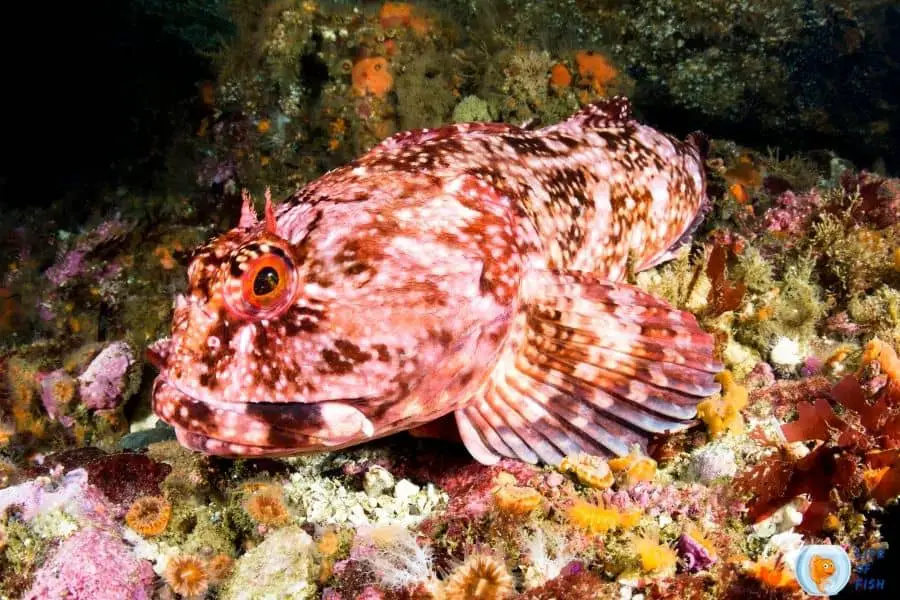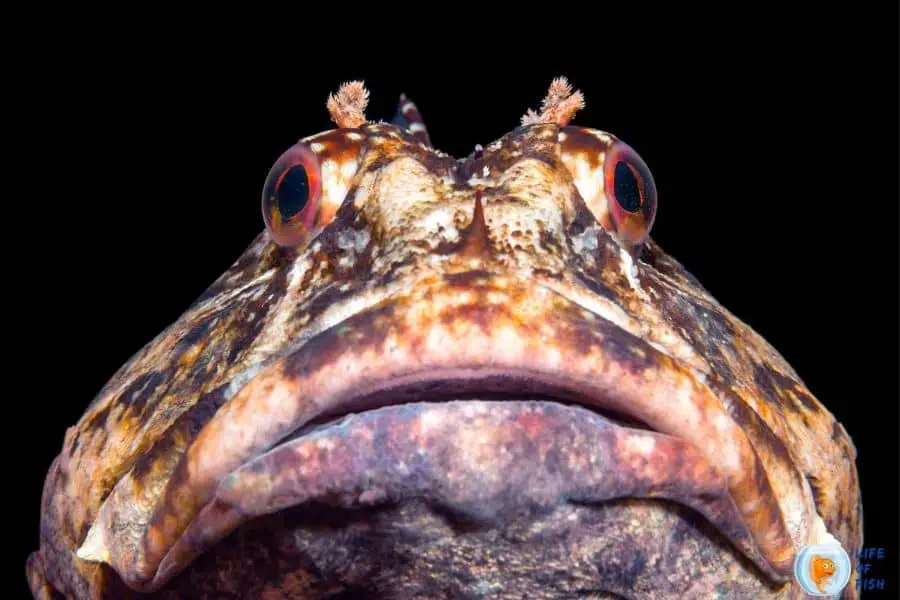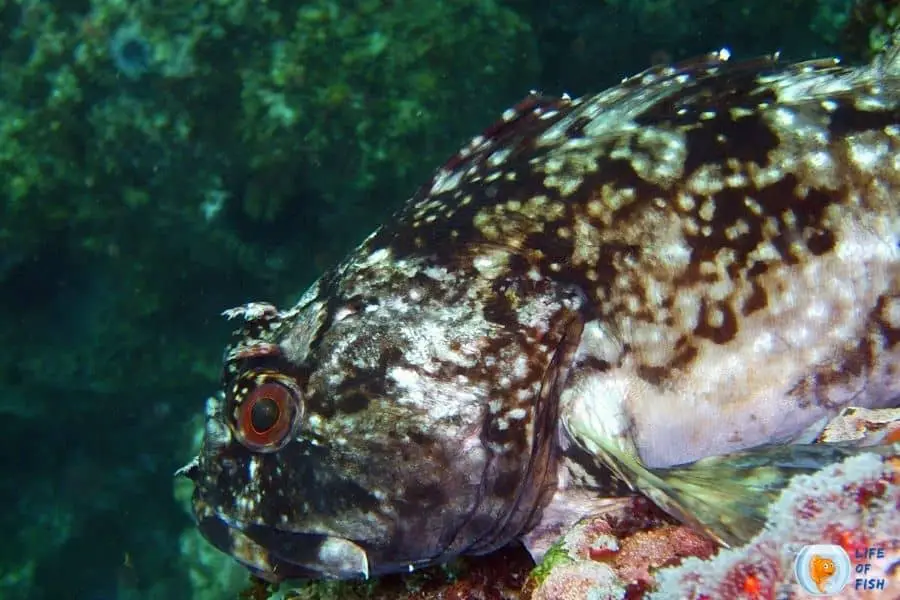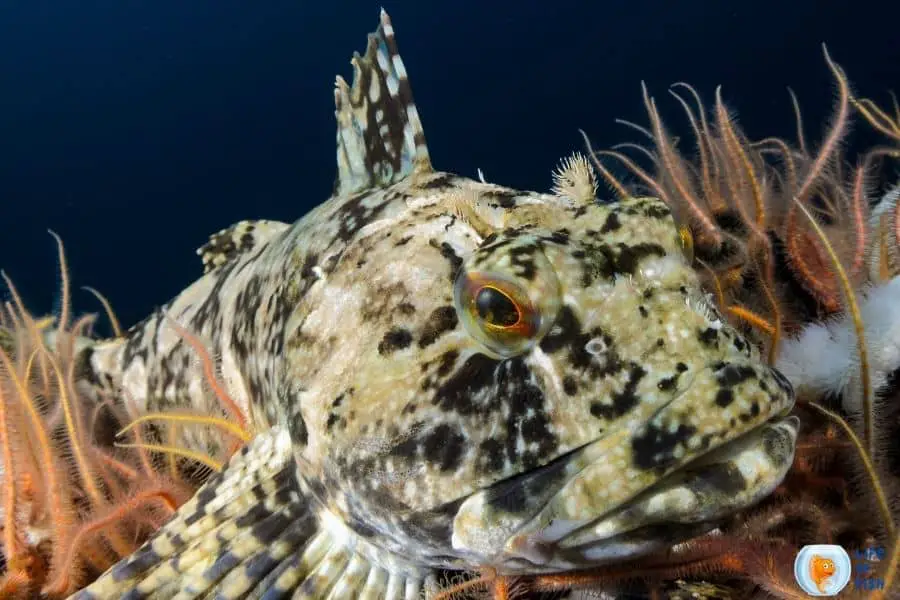Cabezon fish is a unique fish with an exciting attitude that hails from the Pacific coast.
Named after their distinctive large head (Cabezon means “large head” in Spanish), these fish can reach one meter in length and over 11kg in weight.
Cabezons have many alternative names. Bullhead, marbled sculpin, cab, cabby, giant marbled sculpin, scorpion, marble sculpin, bull cod, blue cod, giant sculpin, salpa, and scaleless sculpin are to name a few.
Although these fish are popular as a sport fish and a delicacy, Cabezons eggs are considered poisonous. In this article, we will talk about Cabezon fish in depth.

What is cabezon fish
Jump To
- 1 What is cabezon fish
- 2 How cabezon fish looks like
- 3 Where cabezon fish live
- 4 Is a cabezon a lingcod?
- 5 Cabezon fish behavior
- 6 What does the Cabezon eat?
- 7 Cabezon fish breeding
- 8 Importance of Cabezon fish
- 9 Where can I fish for Cabezon?
- 10 Are cabezon fish poisonous?
- 11 Can you eat cabezon fish?
- 12 What color is cabezon fish meat?
- 13 Related Questions
- 14 Conclusion
Scorpaenichthys marmoratus, commonly known as Cabezon fish, was first introduced by the ichthyologist William Orville Ayres in 1854. It is a ray-finned fish native to the Pacific coast of North America.
Cabezon is a large species of sculpin and the only known member of the genus Scorpaenichthys.
These fish are distributed around the Eastern Pacific ocean, from Sitka, central Baja California, southeastern Alaska to Punta Abrejos and Mexico.
Although the genus name is translated into scorpion fish, they do not call by that name. Fish belonging to the family Scorpaenidae are normally known as scorpion fish
How cabezon fish looks like
Cabezons are well known for their appearance and named after their large head in Spanish.
These scaleless fish are easily distinguished because of their big heads and body color. Adult Cabezons have a mottled pattern on the dorsal side, as well as several blotches and spots.
The ventral surface of the cabezons is white. They have a fusiform body shape and a laterally compressed tail fin.
Color
Cabezons come in various color morphs. They can be brown, bronze, reddish, or greenish above, with a whitish or turquoise green belly.
They have a dark and light mottling on the side and a translucent turquoise green lining on the mouth. The juvenile can be bright red sometimes.
Shape
The most distinct feature of Cabezon fish is its head. The head is more significant than its body, and it has broad bony support extending from the eye across the cheek.
These fish have no scales and a dorsal fin with 11 poisonous spines. It also has a stout spine before the eye and fleshy flaps (cirrus) on the middle of the snout and just behind the eyes.
The anal fin has soft rays. It also has a broad mouth with many small teeth.
Size
According to the scholar reports, Cabezon can reach about 99cm (39 inches) in length and 14 kg (31 lb) in weight.
However, the maximum recorded size was 11kg in weight and 99cm in length. Most fish anglers catch only has a maximum of two feet in length.
Life span
The maximum reported age of these fish is about 13 years. But they usually live as long as 7-10 years.
Male and female fish
Male and female Cabezon fish can be identified by their color. More than 90% of red-colored cabezons are males, while more than 90% of green-colored Cabezons are females.
Other features
Like other fish, Cabezon has an operculum. The first spine of the dorsal fin of these fish is very strong and venomous.

Where cabezon fish live
Cabezons live in a wide range of habitats of up to 200m in depth. They usually live in shallow waters in rocky, muddy, and sandy bottoms.
They are also found in intertidal pools, jetties, kelp forests, rocky reefs and areas with dense algal growth.
According to reports, older fish prefer to go to the deep ocean, as deep as 250 feet and even a depth of 798 feet. In contrast to rockfish and lingcod, which favor the sheer walls of ledges, Cabazons prefer the tops of rocky ledges.
These fish mostly stay motionless anywhere they find, no matter it’s a hole, on the reef, or on vegetation, until they find food.
They are opportunistic feeders that wait until the prey swims within their reach. They usually look for prey along the bottom. They mainly eat crustaceans, mollusks, and other fish.
Cabezons live in the cool water of 22-28 degrees Celsius. They do not tolerate high temperatures or low salinities, but they can survive in waters with poor oxygen content.
They also live in waters with a ph between 5 and 8.
Is a cabezon a lingcod?
Both Cabezon and Lingcod look alike because they belong to the same order. But, Cabezon is not a lingcod because Cabezon belongs to a different family.
Lingcod belongs to the greenlings family Hexagrammidae, while Cabezons belongs to the sculpin family Cottidae.
Both fish lives in relatively similar habitats, but, appearance-wise, they have distinct differences.
Lingcod are brownish in color with grey shades, but cabezons come in several colors. Also, Lingcod has a white spot behind the fish’s eye and a white margin on its dorsal fin, and Cabezon lacks these features.
Cabezon fish behavior
Cabezons are carnivore fish that “lie and wait” until their prey comes near them. Their color lets them blend in with their environment while sitting still.
When food passes by, they lunge at it with their big, powerful pectoral fins and tails and then swallow it with their giant mouths.
Cabezons spawn in shallow waters on the coastline. They are egg-laying fish that practice prenatal care.
The male fish tend to guard the eggs until they hatch, which causes them to expose to anglers. Otherwise, most adult fish often lives in the deep sea as deep as 250 feet and more.
What does the Cabezon eat?
Cabezons feed on a variety of foods which includes meaty food that can fit in its big mouth.
They swallow their food whole without chewing and have a pretty large mouth that can fit rather large fish.
They feed on crustaceans, squids, abalone, mollusks, fish, and fish eggs. Sometimes they also eat garbage from the seafloor.
The Cabezon’s large head shields its eyes from the sand. Some scientists believe that this is why it does not have a nictitating membrane.
Cabezon fish breeding
Cabezon fish breeding season lasts from October to March. They are egg-laying nest spawners that lay eggs to the nests built by male fish.
Once they finish spawning, the female fish goes back offshore, and the male fish start to guard the eggs until they hatch.
Several female fish may lay eggs in the same nest while the same male fish fertilizes them.
Once the eggs hatch, silver-colored fish fry comes out from the eggs and drifts away. Then, the male fish goes back to the shore.
The silvery fish larva settles under floating kelps in the ocean and lives in there until they get old enough.
As they become older, Cabezon tends to settle in tide pools, eventually making their way to the kelp forest to spend their adult life under rocks and hidden in the darkness.

Importance of Cabezon fish
Ecosystem balance
Cabezon fish are secondary consumers of the food chain that eat crustaceans, squids, abalone, mollusks, fish, and fish eggs.
However, these fish become prey to larger fish and marine mammals. Some of the marine mammals that prey on Cabezons are seals, sea lions, sea otters, dolphins, porpoises, and whales.
Cabezon fish are also an important part of the food chain that plays a role in keeping oceans clean.
Their food sources usually eat garbage from the seafloor, decaying organisms, and other wastes and cabezons eat them. This keeps the ecosystem clean.
Sportfishing
Cabezones are known for sportfishing because of their stubborn attitude. Although these fish do not move much, catching them can be frustrating because they often tap or mouth bait and spit it out.
You need to have patience and a sense of when to set the hook in order to catch these fish.
Cabezons are considered a premium sportfish for northern California pier anglers as they are difficult to catch. But, anglers love to fish for Cabezons because of their excellent taste.
As a food
Cabezon meat has low value in the market, maybe because of its color. Cabezon flesh is blue and turns white when cooked.
However, the taste of this meat is excellent. Some say it has a crab-like taste, while others say it has a sweet, shellfish flavor.
Cabezon meat can be prepared in almost any manner and is delicious anyway.
Where can I fish for Cabezon?
These fish are available to catch all year round, except for March and April. The reason is, the fishery is closed during this time.
From October to March, Cabezons spawn in Shallow waters near the shoreline. That is when and where you can easily catch these fish.
Cabezons live in the Nothern Pacific Ocean from Alaska to California. Some well-known places ideal for cabezon fishing are,
- Cabrillo Pier
- Goleta Pier
- San Francisco Municipal Pier
- Point Arena Pier
- Monterey Coast Guard Pier
- Santa Cruz Wharf
- Trinidad Pier and
- Citizens Dock (Crescent City)
Are cabezon fish poisonous?
Cabezon fish are not poisonous and are very delicious when cooked. However, you should be careful when cutting these fish because the roe (eggs) are poisonous to humans.
Cabezon fish eggs contain toxic phospholipids (Dinogunellin), which are poisonous to humans. Therefore you must avoid eating the eggs of Cabezon fish.
Can you eat cabezon fish?
Yes. You can eat Cabezon fish. Although Cabezons are not popular as food fish, the cabezons’ meat is delicious like crabs—those who know the taste of these fish love to catch them for fun and food.
However, these fish have an odd color that many consumers do not prefer. The color might be the main reason that these fish has low demand in the market.
What color is cabezon fish meat?
Cabezon fish has blue color flesh like lingcod that turns white when cooked. The meat is considered to have a sweet, shellfish flavor and can be prepared in any way you like.
You can prepare them by cooking, frying, baking, grilling, or steaming. Cabezon fish meat is also nutritionally rich like lingcod.

Related Questions
What kind of fish is a cabezon fish?
Cabezon fish is a large species of sculpin belonging to the family Cottidae, and it is a ray-finned fish belonging to the class Actinopteri.
Cabezon is the only known member of the genus Scorpaenichthys. These fish are native to the Pacific coast of North America and live in various habitats such as rocky, muddy, and sandy bottoms, intertidal pools, jetties, and kelp beds.
Are cabezon fish rare?
No. Cabezon fish are not rare, hence allowed for fishing under specific rules and regulations.
They are widely distributed around their habitats and have little demand as commercial fish food.
Significant fishing pressure comes from recreational fishing, which is not much compared to commercial fishing that causes the decline of fish species.
Further, the catch has size limits, which helps keep the fishing and fish population under control.
Is Cabezon poisonous?
No. Cabezon fish are not poisonous. They have eggs that contain toxic phospholipids, which may be harmful for human consumption.
It can be prepared as food in various ways. The Cabezon meat is blue in color. When cooked, the meat turns white. The taste of this fish is delicious, like crabs.
What does Cabezon taste like?
As we explained above, Cabezon meat tastes like crabs, and its flesh is delicious. Some say it has a crab-like taste, while others say it has a sweet, shellfish flavor.
Cabezon meat can be prepared in almost any manner and is delicious anyway.
Is Cabezon fish healthy for me?
Yes, Cabezon fish is healthy for you. It contains a lot of nutrients and nutrients like,
- Protein
- Vitamin A
- Niacin (Vitamin B3)
- Vitamin C
- Calcium, and
- Iron.
There are no side effects of eating Cabezon fish, only benefits. If you are allergic to fish or shellfish, then avoid eating them.
Also, avoid eating cabezon fish eggs because the eggs are poisonous to humans.
Conclusion
Cabezon fish is a unique fish that is popular as game fish in the USA. They inhabit North American coastal waters.
These fish mostly remain motionless until they attract suitable prey. Once the unsuspecting fish come closer to Cabezon, it immediately jumps and swallows the fish.
Cabezon fish is delicious, but the eggs are toxic to humans. Therefore, you must remove the eggs before preparing this fish.
Read more Alligator Gar Size | 9 Interesting Facts You Must Know |
